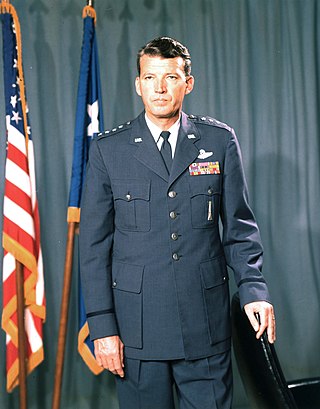The United States Armed Forces are the military forces of the United States. The armed forces consist of six service branches: the Army, Marine Corps, Navy, Air Force, Space Force, and Coast Guard. All six armed services are among the eight uniformed services of the United States.

The United States Space Command is a unified combatant command of the United States Department of Defense, responsible for military operations in outer space, specifically all operations 100 kilometers and greater above mean sea level. U.S. Space Command is responsible for the operational employment of space forces that are provided by the uniformed services of the Department of Defense.

The United States Army Space and Missile Defense Command (USASMDC) is the Army Service Component Command (ASCC) for United States Strategic Command and United States Space Command. It was established in 1985 as the Army Strategic Defense Command, responsible for ballistic missile defense. In 1992, it merged with Army Space Command to become Army Space and Strategic Defense Command. In 1997, it became an Army Major Command and was redesignated Army Space and Missile Defense Command.

Buckley Space Force Base is a United States Space Force base in Aurora, Colorado named after United States Army Air Service First Lieutenant John Harold Buckley. The base is run by Space Base Delta 2, with major units including the U.S. Space Force's Space Delta 4, the Colorado Air National Guard's 140th Wing, the Denver Naval Operations Support Center, and the National Reconnaissance Office's Aerospace Data Facility-Colorado.

Located at Kirtland Air Force Base, New Mexico, the Air Force Operational Test and Evaluation Center is a direct reporting unit of Headquarters, United States Air Force. It is the Air Force independent test agency responsible for testing, under operationally realistic conditions, new systems being developed for Air Force and multi-service use.

Space Systems Command (SSC) is the United States Space Force's space development, acquisition, launch, and logistics field command. It is headquartered at Los Angeles Air Force Base, California and manages the United States' space launch ranges.

John William Raymond is a retired United States Space Force general who served as the first chief of space operations from 2019 to 2022. The first guardian, he served as commander of the United States Space Command from 2019 to 2020.
The transformation of the United States Army is part of a strategy using Multi-Domain Operations (MDO). In 2019, the planning was for Large Scale ground Combat Operations at echelons above the brigade combat team. Multi-Domain Task Forces operate in a combatant commander's theater.

The United States Army Futures Command (AFC) is a United States Army command that runs modernization projects. It is headquartered in Austin, Texas.

Space Operations Command (SpOC) is the United States Space Force's space operations, cyber operations, and intelligence field command. Headquartered at Peterson Space Force Base, Colorado, it consists of its mission deltas, and garrison commands.

John F. Bentivegna is a United States Space Force chief master sergeant who serves as the second and current chief master sergeant of the United States Space Force. He previously served as the senior enlisted advisor to the deputy chief of space operations for operations, cyber, and nuclear and senior enlisted leader of Space Operations Command.

Bradley Chance Saltzman is a United States Space Force general who is the second and current chief of space operations. He served as the deputy chief of space operations for operations, cyber, and nuclear from 2020 to 2022. He is the first lieutenant general and the first general officer promoted into the Space Force.

William J. Liquori Jr. is a retired United States Space Force lieutenant general who has served as the deputy chief of space operations for strategy, plans, programs, requirements, and analysis from 2020 to 2022. A career space operator, he has operational experiences in support of Operation Southern Watch and Operation Enduring Freedom.

Space Training and Readiness Command is the United States Space Force's education, training, doctrine, and test field command. It is headquartered at Peterson Space Force Base, Colorado.

The United States Space Force is organized by different units: the Space Staff, the field commands, and the space deltas.

While the United States Space Force gained its independence on 20 December 2019, the history of the United States Space Force can be traced back to the beginnings of the military space program following the conclusion of the Second World War in 1945. Early military space development was begun within the United States Army Air Forces by General Henry H. Arnold, who identified space as a crucial military arena decades before the first spaceflight. Gaining its independence from the Army on 18 September 1947, the United States Air Force began development of military space and ballistic missile programs, while also competing with the United States Army and United States Navy for the space mission.

The Space Warfighting Analysis Center (SWAC) is a direct reporting unit in the United States Space Force responsible for conducting analysis, modeling, wargaming, and experimentation to create operational concepts and force design guidance for the service. It is the Space Force's counterpart to the Air Force Warfighting Integration Capability and United States Army Futures Command. It is headquartered at Washington, D.C.

The director of staff of the United States Space Force (SF/DS) is a senior leadership position in the United States Space Force held by a major general. The director of staff reports to the chief of space operations (CSO) and has overall responsibility for providing executive staff to the CSO, vice chief of space operations, and chief master sergeant of the Space Force.

The United States Space Forces – Space (S4S) is the United States Space Force component field command to the United States Space Command. It was formed by combining the Combined Force Space Component Command and Joint Task Force–Space Defense. Its commander also serves as the combined joint force space component commander (CJFSCC). It was activated on 6 December 2023.

















